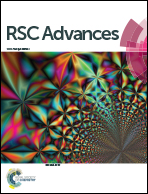Investigation of adsorption and photocatalytic activities of in situ cetyltrimethylammonium bromide-modified Bi/BiOCl heterojunction photocatalyst for organic contaminants removal†
Abstract
Bi/BiOCl heterojunction was prepared via a hydrothermal method, using cetyltrimethylammonium bromide (CTAB) as a stabilizing agent. The structure and chemical properties of Bi/BiOCl with the three different CTAB contents were thoroughly analyzed by X-ray diffraction (XRD), X-ray photoelectron spectroscopy (XPS), Fourier-transform infrared spectroscopy (FTIR), field-emission scanning electron microscope (FESEM), high resolution transmission electron microscope (HRTEM), UV-vis diffuse reflectance spectra (UV-vis DRS), zeta potential, and carbon element analysis, the results indicates that there are some important interactions between CTAB and Bi/BiOCl, resulting in decreasing the band gap of Bi/BiOCl with the increase of CTAB content. Two typical dyes, rhodamine B (RhB) and methyl orange (MO) which has different surface charges, were choosed as the target pollutants. Under the visible light (λ = 420 nm), the photocatalytic efficiency of Bi/BiOCl with a higher CTAB (Bi/BiOCl-a) was 3.72-fold more than that of Bi/BiOCl with a lower CTAB (Bi/BiOCl-c) to remove RhB. Bi/BiOCl heterojunction alone exhibited a poor degradation capability for the MO such as 5% of MO photodegradation with Bi/BiOCl-c. In contrast, MO removal efficiency by the Bi/BiOCl-a was 100%. Hence, the CTAB could play an important role to enhance the removal of dyes. Firstly, CTAB could absorb the target pollutants near the surface of Bi/BiOCl due to the electrostatic attraction and dispersion interaction; then Bi/BiOCl could degrade the pollutants via the in situ h+ or ˙O2− under the visible light. The proposed mechanism was supported by the FTIR and adsorption analysis.


 Please wait while we load your content...
Please wait while we load your content...